Vilhelm Hammershøi, Interior of Woman Placing Branches in Vase on Table, 1900. Stillness: Hammershøi and American Minimalism.
What we continually chase as art lovers are those rare moments when the unexpected reveals itself. Often, the vision of inspired curation can show relationships and insights we wouldn’t otherwise discover. Subsequently, our perspectives can shift, even of art we think we know well. Such is the case with the PhillipsX exhibition Stillness: Hammershøi and American Minimalism, on view at 432 Park Avenue through 17 May.
The exhibition showcases exceptional works by Danish painter Vilhelm Hammershøi alongside works by American Minimalists, shining new light on the ways of seeing each. Featuring first-rate works by Hammershøi together with those of Anni Albers, Sol Lewitt, Agnes Martin, Kenneth Noland, Robert Ryman, and many more, the exhibition showcases the elemental expression and visual distillation each artist explored, creating a visual through-line among the grouping that is as revealing as it is unexpected.
Several of the Hammershøi works on view are on loan from the remarkable Collection of Ambassador John L. Loeb Jr., and are only rarely seen in public. Mr. Loeb, a gentleman with a strong legacy in the arts, commerce, and philanthropy (his family name graces the Francis Lehman Loeb Art Center at Vasser College, and he is descended from the founders of two historically important financial firms), served as the US Ambassador to Denmark from 1981 to 1983. It was during this time that he amassed a sophisticated collection of Danish art that is now unquestionably the most significant in the United States.
Here, we highlight the recent re-awakening to Hammershøi’s work and the surprising discoveries glimpsed when it’s viewed alongside American Minimalism.
A Hammershøi Moment
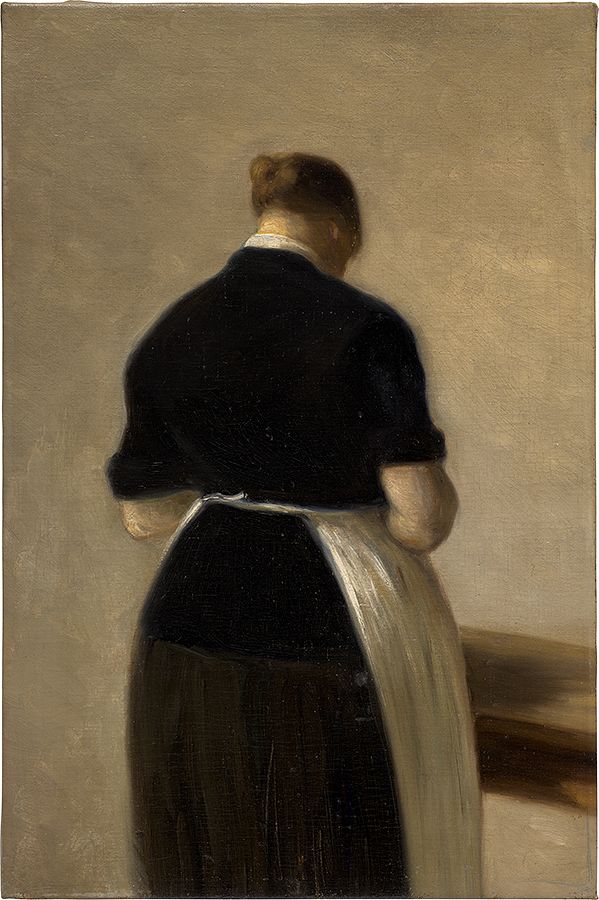
Vilhelm Hammershøi, Study of standing woman, seen from behind, 1884/1888. Stillness: Hammershøi and American Minimalism.
It was only relatively recently that Hammershøi’s works began to be considered within the context of Modernism. Ever since his works first gained global attention with the 1982 exhibition Northern Light: Realism and Symbolism in Scandinavian Painting, 1880–1910 at the Brooklyn Museum in New York, they have often been compared to Johannes Vermeer. The Dutch Master was clearly an influence on Hammershøi, but it’s when recast in a Modern light that the subtlety of Hammershøi’s avant-garde approach emerges.
Jeremiah Evarts, Phillips’ Deputy Chairman, Senior International Specialist of Modern & Contemporary Art, and an expert on the artist, was among the first to explore this idea, recontextualizing Hammershøi in the Modern and Impressionist category. He now finds more to explore in his works than ever, remarking that “it’s quite transcendent to look between what the Minimalists find and what Hammershøi finds.” He points out striking similarities between them: they each employed a limited palette that removes bright primary colors and they worked in series, returning to the same subjects repeatedly — whether that’s Hammershøi’s daringly sparse interiors featuring his wife Ida, often turned away from the viewer, or the grid-like patterns consistently explored in the works of Agnes Martin or Anni Albers. “There is a stillness, depth, and calm interiority that links Hammershøi with American Minimalists,” he explains.
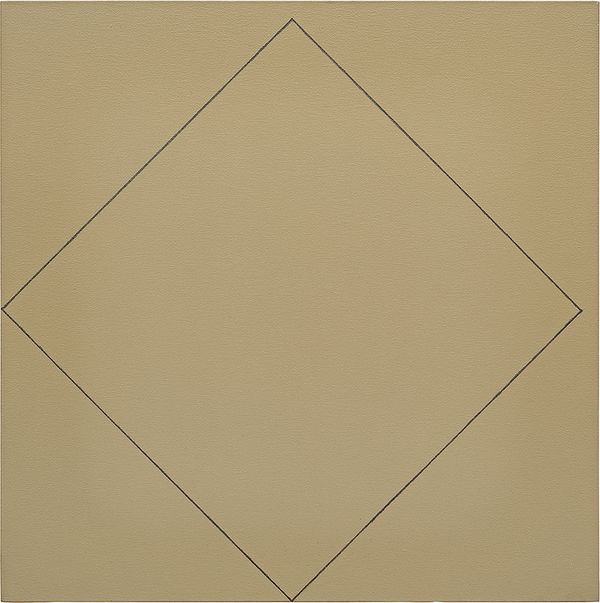
Robert Mangold, Square Within a Square (Warm-grey), 1974. Stillness: Hammershøi and American Minimalism.
The exhibition comes on the cusp of a major moment in the understanding of Hammershøi’s creative output. “Museums are re-evaluating their approach to Danish painting,” Evarts tells us, noting that Hemmershøi’s works have recently been acquired by major American institutions, including the Getty Museum, the Art Institute of Chicago, and the Santa Barbara Museum of Art.
A Shared Approach
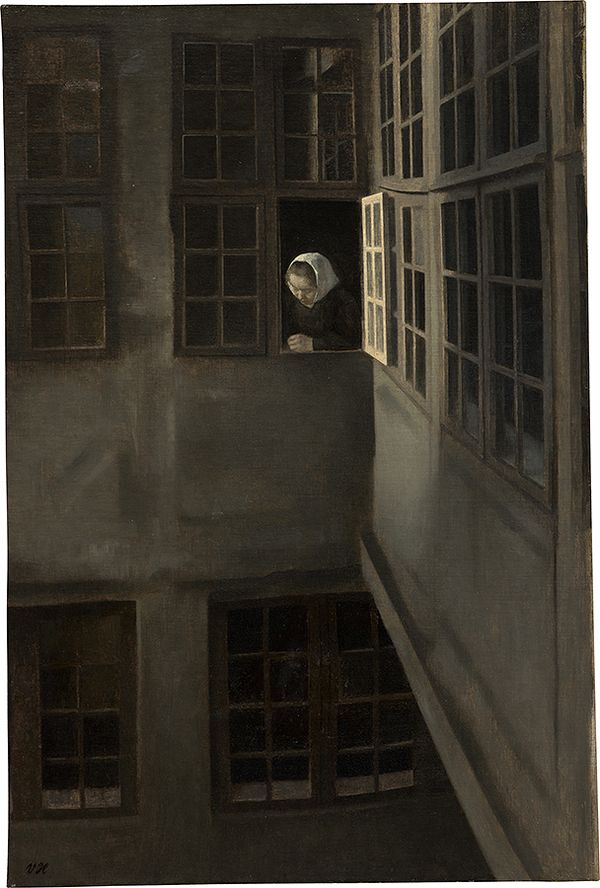
Vilhelm Hammershøi, Courtyard Interior at Strandgade 30, circa 1905. Stillness: Hammershøi and American Minimalism.
From the Collection of John L. Loeb Jr., Hammershøi’s Courtyard Interior at Strandgade 30 is among the most striking works in the exhibition, showcasing the artist’s ability to refine a composition to its core elements. Executed at a time when the artist and his wife shared two different apartments a few doors away from each other in the same building, the work depicts an exterior scene but maintains Hammershøi’s characteristic interiority — both actual and psychological. The work’s emphasis is on the building and the grid-like pattern of the windows looking into it, rather than on the outside world. The lone female figure characteristically looks away from the viewer. On closer look, the grid-like patterns of the windows are slightly off-kilter, yet at root, reminiscent of Minimalism. When we compare this work to the optical impression of Anni Albers’ Triadic DR III— with its captivatingly obsessive intricacy and limited color palette — we discover that each work represents a similar visual idea distilled to its purest form.
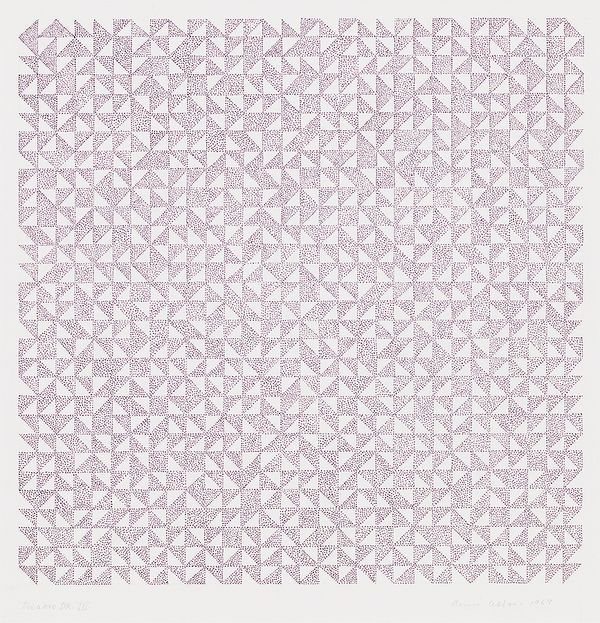
Anni Albers, Triadic DR III, 1969. Stillness: Hammershøi and American Minimalism.
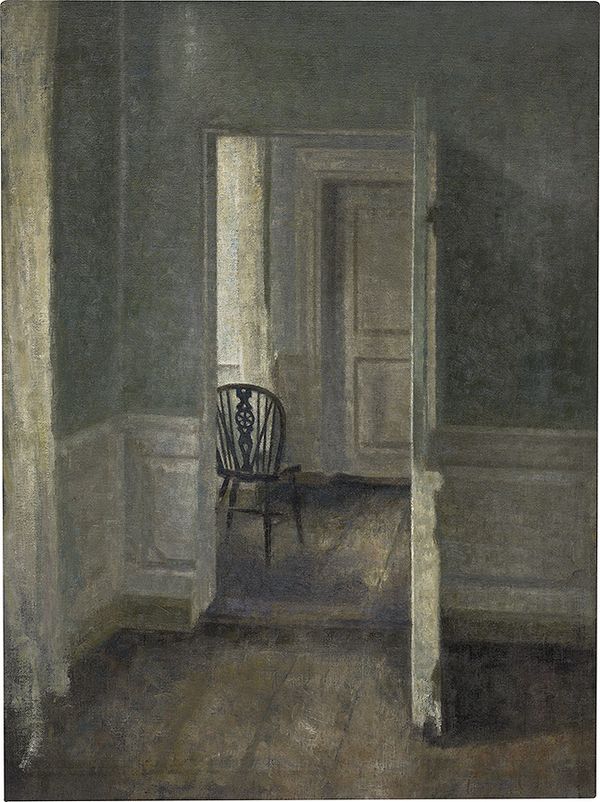
Vilhelm Hammershøi, Interior with Windsor Chair, 1913. Stillness: Hammershøi and American Minimalism.
Hammershøi’s Interior with Windsor Chair showcases the unique way the artist treats the meeting of line created by the structural elements of a building — here, the horizontal lines of the composition slope downwards. The extraordinarily sparse interior scene seems to suggest a visual repetition in that the room we’re looking into may be identical to the one we’re in. It also implies the presence of a human figure that we cannot see behind a closed door, framing the composition but also shutting us out. When compared to Agnes Martin’s Untitled #10, we’re struck by the similarity of horizontal lines dominating each composition — and again asymmetry, a limited color palette, and the use of repetition to suggest the image continues beyond the frame.

Agnes Martin, Untitled #10, 1998. Stillness: Hammershøi and American Minimalism.
Even more striking comparisons and throughlines can come to light when viewing the exhibition. Where Hammershøi distills his scenes to their bare elements, rejecting the decorative bourgeois interior at a moment when the Western world grappled with political revolutions and modernization, we see Robert Ryman remove almost all sense of the decorative from his work several decades later. And where Hammershøi places subjects in a slightly abstracted depiction of the built environment, finding pure line in interior structures, much of the work of the Minimalists uses pure line and shape as a subject in itself. In fact, the exhibition has the potential to elicit as many new comparisons as there are viewers, which is all the more reason to visit. You may just discover a new way to see.
Stillness: Hammershøi and American Minimalism is on view through 17 May at Phillips New York and runs alongside the preview of Phillips’ marquee Modern & Contemporary Art auctions.
Discover More from Modern & Contemporary Art >
Recommended Reading
Artists to (Re)discover >
